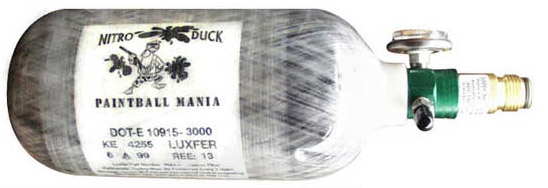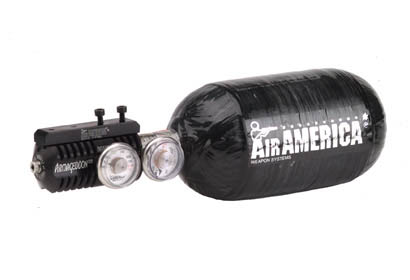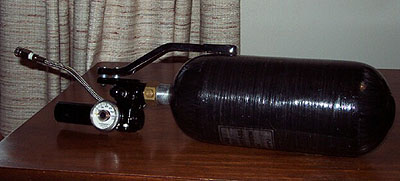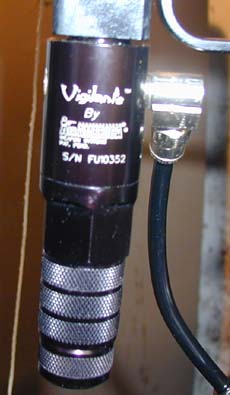|

Nitro Duck Preset HPA
Having played paintball for about seven years now, I have had the opportunity to use a wide variety of products related to paintball.
Every once in a while I will find a product that I like so much that I will refuse to use anything else. Paintball started using 12 gram CO2 and then went to constant air CO2. CO2 will not likely ever be completely phased out of the sport. However, as nitrogen tanks continue to get cheaper, and fills more available at fields, I believe we will see more and more players using them.
I have used tanks by Paintball Mania (Nitro Duck), Air America, and PMI. I have always gone back to Paintball Mania. The reasons for this are pretty easy to understand: their products are very high quality and just dont seem to leak or break down at embarrassing moments. I cannot say the same thing from my experience about PMI Pure Energy tanks or some of the regulators made by Air America.
Now, when buying a nitrogen system it is important to understand exactly what you need and what you do not need. If you are running an inline regulator that is worth the money you paid for it, a preset tank is all that you need. If you are have a high-end gun such as a newer Bushmaster 2000, Defiant, Impulse, or Angel, the regulator that comes with your gun will work perfectly fine. If you shoot an Autococker or another high-end gun without an inline regulator built in, you will probably want to purchase a high-pressure regulator like a Palmer Stabilizer, AKA Sidewinder, or ANS Gen-X regulator. Guns such as Spyders and Tippmanns, which are designed for input pressures around 700-800psi, do not need an inline regulator unless you want extra pressure consistency.
The reasoning behind this is because the inline regulator on your gun will act just like the second regulator on an adjustable tank. Why pay extra for something that you do not really need? A preset tank offers the versatility of CO2 and is not going to run you close to $400 like many of the adjustable tanks will.
Screw-in tanks are easier to remove from your gun, which makes safe storage and cleaning of your paintgun a much more manageable task. Also, because it does not have an extra regulator that most players won't need anyway, a preset tank setup is considerably lighter than most adjustable systems. This is something anybody that plays up front definitely needs to take into consideration.
The Paintball Mania preset tanks are somewhere in the middle as far as nitrogen tank prices go. They are more expensive than PMI tanks and some other brands, but they are obviously going to be less expensive than Angel Air or some of the other more expensive setups like Max-Flow or Armageddon. If you have used older model 3000psi tanks, the newer models work pretty much the same. The only differences are that Paintball Mania now uses a smaller gauge which does not get hung up on your drop forward as often, which can be a tremendous pain. Thankfully, they have discontinued using a non-standard fill nipple on 4500psi tanks.
Drawbacks? The only I have experienced is that I have noticed that the gauges on these tanks are very easy to break. This is somewhat annoying because having a working gauge on your tank is something I consider to be a necessity. I also wish that Paintball Mania would include a fill nipple protector with their tanks. It would be a nice bonus that probably would not cost them very much. Also - (this is by going from information given by their website) that they offer the LT (88ci) setup for 3000 psi but the only tank larger than 68ci for 4500psi is a 110ci. I think it would make more sense for them to switch this around and offer the 110ci for 3000psi and the LT (88ci) setup for 4500psi.
In conclusion, you may be assured that if you buy from Paintball Mania, you will receive a high quality product that will serve you well in years to come.

Air America Armageddon 4500Review: Unlike Air America's other popular product lines, the Apocalypse and the Raptor, the Armageddon is available only in a 4500 psi setup. The bottle size of the one in this review is 68ci. Depending on your marker setup, you can expect between 1,000 and 1,300 shots per 4500psi fill. The Armageddon is a relatively light system, and this is due to the fact that instead of using stainless steel for the bulkier parts of the regulator, it is constructed mainly of aluminum. It is adjustable from 0 to 1200 psi without requiring a spring change for lower pressures. The bottle is threaded and can be detached from the regulator sleeve by unscrewing it.
Pros:
The Armageddon system is a work horse. It holds up great, and doesn't skip a beat as you play through the day. Its weight is about the same as most other nitro systems, and isn't as heavy as its cousin, the Apocalypse. The ease of mounting the system to your marker is also great. With the twist of a small set screw, the whole tank system is off the gun, or just as easily, re-mounted. It's great for the player who tries to get the perfect shoulder on his gun, or the person that packs up tight, and needs to disassemble the whole marker set up after a hard days play. I have yet to personally break the system down, but if it's anything like other Air America systems, it is easily serviceable by yourself with a few o-rings and regulator seats. As always, you can send it to the factory and they can take care of any problems as a last alternative. The dual gauges are also a great feature, allowing you to view both the pressure left in the tank, and the output pressure to your market. The regulator is adjustable through the front screw with an allen wrench. Another big plus for the system is consistency. With a secondary regulator to help, I was getting +/- 2 or 3 FPS at the chrono.
Cons:
The whole setup, like most HPA tanks, can get heavy, especially on a hefty gun after long days of play and running around. Of course, I just might be weak.  Another con is the lack of on/off system like the Apocalypse had. It is very hard to unscrew the bottle with 4500psi in the bottle pushing it's self into the regulator. It's also quite an expensive system, landing in the $400 plus range, depending on where you buy it. But it is a high end system after all, and with that generally comes a high end price tag. Something else I noticed is that the regulator is not that great of a performer at lower pressures. Below 300 psi or so, I noticed it's not nearly as consistent as it is at higher pressures. Also, it really tends to need a secondary regulator before getting to your market. I personally have the ANS Gen X-2, and it works great with my AutoCocker and Armageddon combo. This, or course, can add even more to the price tag. Another con is the lack of on/off system like the Apocalypse had. It is very hard to unscrew the bottle with 4500psi in the bottle pushing it's self into the regulator. It's also quite an expensive system, landing in the $400 plus range, depending on where you buy it. But it is a high end system after all, and with that generally comes a high end price tag. Something else I noticed is that the regulator is not that great of a performer at lower pressures. Below 300 psi or so, I noticed it's not nearly as consistent as it is at higher pressures. Also, it really tends to need a secondary regulator before getting to your market. I personally have the ANS Gen X-2, and it works great with my AutoCocker and Armageddon combo. This, or course, can add even more to the price tag.
Overall:
I'm very pleased with this system. The easy mounting and simple usage are a sight for sore eyes in the high pressure air world. The fact that it's not as likely to go down as much as other systems is also a plus. I dont have to worry on the field wether my tank is going to perform or not. The price tag does make it out of range for some people, but as the trend goes, people seem to not have a problem forking out the cash. You get what you pay for and with this system youre going to get a lot. There are also after market options such as matching anodizing to the regulator, and a thumb adjuster that goes on the front to rid yourself of using the allen key. I'm happy with my tank, as are the several thousand people that own them.

Smart Parts Max-Flow
Ever since compressed air (nitrogen) has been used in paintball there has been a need for companies to create quicker recharging, higher flow tank systems. Smart Parts has accomplished this feat by creating one of the best nitrogen systems money can buy. The Max-Flow has it all. Welleverything but good looks. The Max-Flow nitrogen system is made for use on any gun, but because of its high flow rate, is the best overall system for low pressure markers. The Max-Flow was built to maintain the most consistent air pressure output to the marker even as pressure in the tank drops. An interesting feature of the Max-Flow is that it will externally vent excess air to avoid sending too much pressure to your gun. Also, it is very easy to adjust.
All you do to adjust the Max-Flow regulator is back the regulator ring/cap out a bit, and then adjust the pressure using the manifold. Then all you have to do is screw the regulator cap/ring tight to the manifold, and you're ready to play. Because some fields may not like this easy design due to possible cheating because the regulator cap backs out easily and could theoretically be altered while on-field, On Target Products has made a locking regulator ring that does not allow you to access the manifold without a tool.
3000 psi vs. 4500 psi:
Max-Flow 3K and 45K nitrogen systems are very alike. There are some small differences, however.
The 3000psi systems come with a removable tank, and the newer systems have a built in tank. The reason for this is that the 3000 psi Max-Flow is capable of running on either compressed air or CO2. The 4500psi systems have an on/off lever on the regulator assembly where the 3000psi systems have an on/off knob on the actual tank. If size is an issue for you, the new 45K systems have a smaller manifold, which is a great improvement and makes for a slightly more compact gun setup as an end result.
Pros:
There are many reasons why the Max-Flow is hands down one of the best tanks on the market. For one reason, it has the Maximum flow rate, as the name advertises, unless the results have been overturned by new product developments. Over the chrono, I shot a string of paint at 289,289,289,287, 289FPS. Consistency like that can really help your accuracy! If every ball is going nearly the same speed, you're likely to get paint where it needs to be without some balls dropping early or flying high. Even the smallest amount of velocity change can add or subtract distance from your shot, taking away precious accuracy. Another advantage of this fantastic consistency is that you really don't need a secondary regulator at all to gain this kind of performance. My string of chronoing paint was shot with no inline regulator besides the Max-Flow.
Cons:
The Max-Flow does have a very difficult to mount design. It is easy to mount if you remove the four screws holding on the manifold, and then mount the tank receiver, and then put the manifold back on. But this is harder than most other system mounts, like the simple dovetail rail on some Air America nitrogen systems, or the extra-simple variety of screw-in air tanks such as the ACI Bulldog. The Max-Flow also is rather large. In fact, it is considerably larger than most other systems on the market, and can make for a less compact setup if you choose to run it on-gun. It also requires regular cleaning, which can be tough if you dont stick to it. Keep it clean and free of dust and debris or you may find yourself taking it apart for a good thorough cleaning, or even shipping it back to Smart Parts for problem that you just might not be able to figure out.
In a Nutshell:
The Max-Flow is truly a great compressed air setup. Although it does have a high price tag($350 for 3k systems, $450 for 45K) compared to competing products from other manufacturers, I feel the price is justified in the extremely high quality and end-result of the system. If you must have the best tank, and money is no object, this could be the tank for you. The size and looks may seem like a turn-off to some people, but I believe the performance will impress you.

Air America Vigilante
Famous for their extensive line of high-pressure air systems for Paintball, Air America hit the low-price inline regulator market with a bang by introducing the Vigilante in 1999. Still readily available today, the Vigilante has been recognized as one of the best regulators available in any price range. With the simple changing of the main spring, it can be set from 0 to 1200 PSI output pressure, making it viable for any marker available today.
The road to excellence in accuracy has three stops on it: Barrel quality, paint-to-bore match and consistent velocity. The key to consistent velocity is of course, the same amount of gas propelling the ball out of the barrel each time you pull the trigger. The best way to make sure this is achieved is via an inline pressure regulator. Now, nearly all regulators will deliver a consistent flow of gas given enough time to recharge the pressure, but the secret to a real high performance regulator is the ability to recharge in a very short amount of time, and cycle quickly once the marker is fired (thus relieving the pressure). The Vigilante has a high recharge rate, and is suitable on any of todays high rate of fire markers.
Another common malady of the regulator world is the use of CO2 as a propellant. Air America hit the nail on the head with the vigilante, as it works well with both HPA and CO2 setups. The Vigilante excels when using HPA, but unlike some regulators on the market (even others by Air America) the Vigilante can indeed function on CO2. As with all CO2 setups, it is advised to run an anti-siphon tube in the tank to ensure the minimum amount of liquid CO2 is entering the regulator, but the Vigilante can actually handle liquid in small amounts.
The Vigilante is also reputed to have one of the higher flow rates of all regulators available today. This means that for all you low-pressure gun users (such as some modified Cockers, Bushmasters, Spyders, etc) there wont be any air starvation problems from lack of airflow, provided you use a high flow hose system like steel braided or macroline.
Another great feature on the Vigilante is dual input ports, which can be handy because it allows you to mount your hose setup on either side of the reg. This allows you to customize your setup according to how you grip the regulator when firing. Also included is an output port that lies between the two input ports, which can be used to mount a gauge (or something else,for the more creative tinkerers out there).
Adjusting the Vigilante is a simple task. Simply unscrew the bottom cap, which is similar to the cap of a 2 liter bottle, and use either a quarter, a flathead screwdriver, or even the correct size Allen wrench. Tighten to increase pressure, or loosen to decrease. Remember to give the regulator at least one clearing shot after adjusting pressure, so that the new setting has time to take effect.
Maintenance of the Vigilante is simple: place a few drops of paintgun-approved oil (Sewing Machine oil works perfectly) in your guns ASA (where you screw in the tank) and fire the gun with no paint loaded several times, giving the oil time to run through the works of the regulator and marker.
The Vigilante is available in two different color configurations, Black top and red bottom, or all black. Also for a small price, a replacement spring can be ordered from just about anywhere that sells the Vigilante itself, in case you need to switch between high and low pressure operation.
Overall, the Vigilante is a superb regulator with high flow and easy maintenance, and at a price between 55 and 75 dollars it would be a challenge to find better, regardless of price.
|

